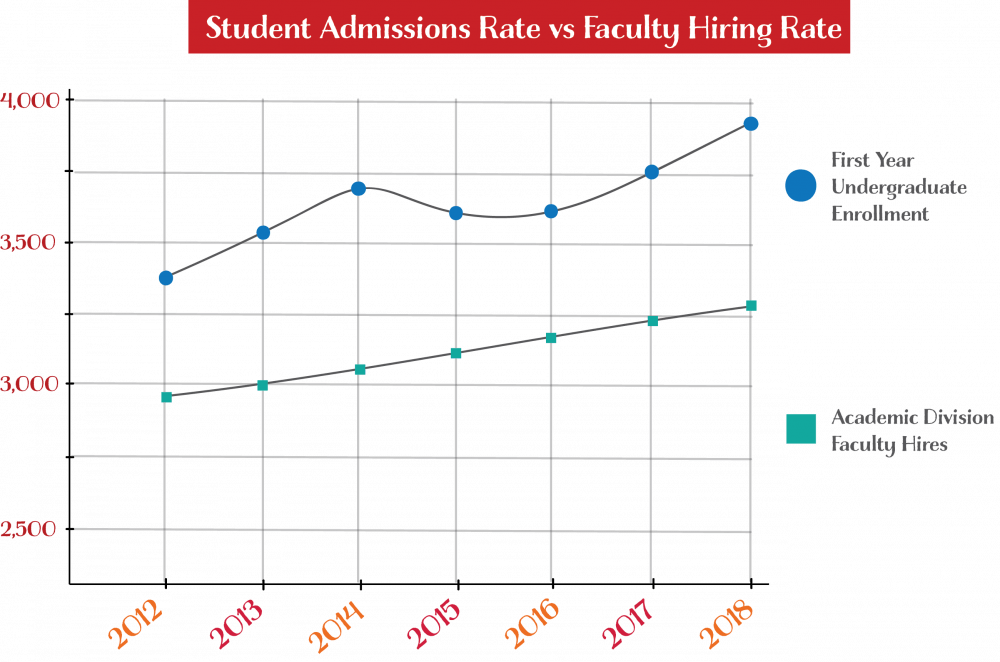For the past several years, first-year enrollment at the University has steadily risen, increasing 12.5 percent between fall 2012 to fall 2018. In fall 2012, 3,397 first-year students arrived on Grounds, while in fall 2018, the University welcomed a first-year class of 3,822 students — the largest first-year class in University history.
As undergraduate enrollment numbers have climbed in recent years, the University faculty population has also risen, although at a lower rate of increase than the University’s undergraduate population. Since 2012, the number of faculty in the academic division has grown 7.5 percent — increasing from 2,991 faculty members in fall 2012 to 3,216 in fall 2018.
In fall 2013, former President Teresa Sullivan discussed her concerns about the generational turnover of University faculty during a meeting with the Board of Visitors and the Special Committee on Strategic Planning. In an email statement to The Cavalier Daily, Maite Brandt-Pearce, the vice provost of faculty affairs, said the problem of generational turnover among faculty members was endemic in academia at the time.
“In 2012, one of the things that we recognized was that not only did we here at UVA have an aging faculty, but the same phenomena was occurring across the US,” Brandt-Pearce said. “The retirement bubble that we were facing was a problem across higher education. This meant that not only were we going to have to recruit a larger number of faculty, we were going to face increased competition for those faculty.”
In order to recruit faculty members in an increasingly competitive market, the University incorporated faculty hiring into The Cornerstone Plan — the current strategic plan for the University created under Sullivan and approved by the Board of Visitors in Nov. 2013. The plan aims to provide a blueprint for the University’s future based of five pillars. One of those pillars seeks to “assemble and support a distinguished faculty” by promoting faculty leadership development, recruiting faculty continuously and hiring faculty from diverse backgrounds.
Diversity among faculty members has historically been a contentious issue at the University. During an interview with The Cavalier Daily in Feb. 2019, President Jim Ryan said that faculty diversity is a key issue at the University. He added that, although there is more work to be done, the efforts of the past administration have worked toward diversification of faculty demographics.
According to Institutional Assessment and Studies Universal Data, around 24 percent of the total staff at the University is non-white, which includes employees identified as non-resident aliens. However, the University student body is 43.2 percent non-white — revealing a discrepancy in the ability of the faculty to accurately represent racial diversity within the student body. Efforts to increase diversify University faculty have included investment in research infrastructure and faculty funding through the Strategic Investment Fund and increased interdisciplinary hiring.
Board of Visitors Rector Frank M. “Rusty” Conner said in an email statement to The Cavalier daily that the provost’s office had successfully worked to implement the strategies in the Cornerstone Plan.
“The Provost Office deserves a great deal of credit for encouraging cluster hires and cross-disciplinary efforts to attract outstanding faculty,” said Conner. “This has been a very successful strategy where several departments or schools team up to make one or more hires who will have multiple school appointments.”
Brandt-Pearce said that the strategic hiring process at the University has evolved in recent years to accommodate new goals and an ever-changing labor market.
“We have instituted a faculty hiring process to support our new pan-university institutes by conducting searches by topic rather than strictly by department,” Brandt-Pearce said. “We have developed robust policies for academic general faculty that have been recognized nationwide as outstanding models for attracting and supporting exceptional teaching faculty to enhance the educational mission.”
Brandt-Pearce explained that the University seeks status as a competitive employer in part through faculty salaries. According to the American Association of University Professors ranking of faculty salaries, the University ranks number 29 among all U.S. universities in faculty salaries, with an average salary of $81,214 in 2017. In comparison, the average salary at Virginia Tech during the same year was $69,558 and the average salary at William & Mary in 2017 was $71,095.
However, discrepancies in salaries do exist, as male professors at the University earn an average salary of $180,470 — $23,559 more than female professors, who are paid $156,911 on average. According to the Office of the Executive Vice President and Provost’s Faculty Salary Study Task Force’s 2014 report, which utilized confidential information from regarding tenured and tenure-track faculty in all of the schools except Medicine for 2003, 2007, 2012 and 2013, male faculty members earned 2.7 percent more than their female counterparts. The report also noted that male faculty members constitute a majority of the faculty and have held their positions for longer periods of time — 18.5 years on average versus 12.4 for female faculty members.
Although growth in first-year enrollment has outpaced faculty growth since The Cornerstone Plan’s implementation, student to faculty ratios have remained relatively consistent since 2015. According to the University’s Institutional Assessment and Studies data, undergraduate student to faculty ratios were 12.9 in 2015, 12.0 in 2016, 11.8 in 2017 and 12.1 in 2018. This is on par with ratios at other public institutions in Virginia — Virginia Tech reports a 14:1 student to faculty ratio, while William and Mary’s ratio is 11:1.
While student-faculty ratios remain relatively unchanged throughout the years, Brandt-Pearce said the University has seen challenges in staffing certain programs and departments due to their fast-paced growth. For example, the Media Studies department has restricted course enrollment to majors only due to limitations posed by the lack of faculty available to satisfy student demand for courses.
“There are programs and departments that have wanted to grow faster than the pipeline of available candidates has supported,” Brandt-Pearce said. “These programs have employed aggressive measures to enhance their offer packages, with substantial success in some domains and less in others.”





